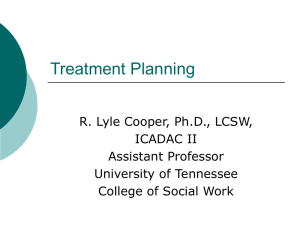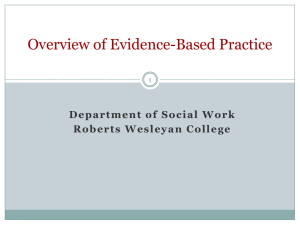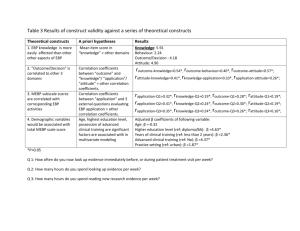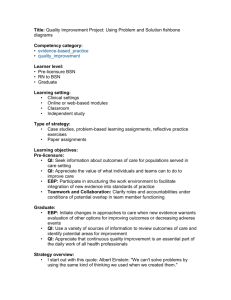Evidenced-Based Social Work Practice
advertisement
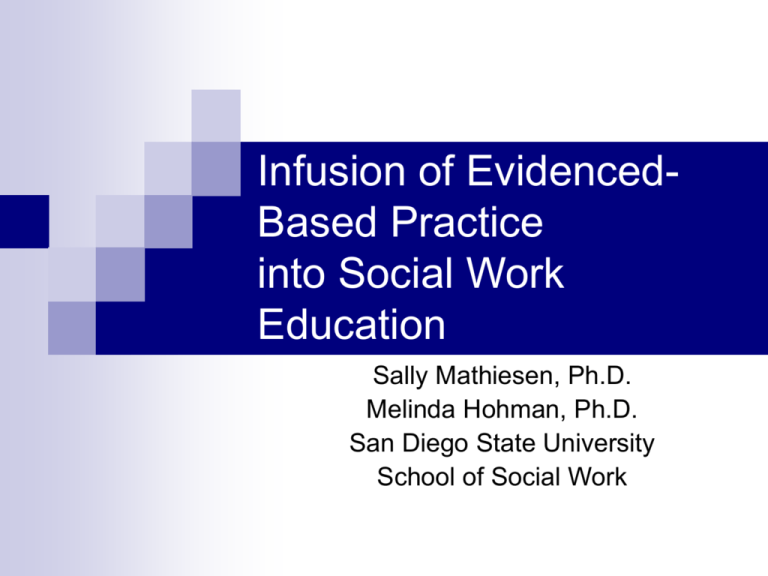
Infusion of EvidencedBased Practice into Social Work Education Sally Mathiesen, Ph.D. Melinda Hohman, Ph.D. San Diego State University School of Social Work Evidence-Based Social Work Practice Education: What is it? “Educating social workers to: •Be consumers of the research literature •Use systematic approaches to increase their practice effectiveness and •Continuously evaluate their own practice outcomes.” Pollio, 2006 2 Curriculum Issues Students need to understand issues in each box and how they all integrate with each other: Scientific methods (Research) Critical thinking (Research, Practice, Policy, HBSE, Field) EBP process (Research, Practice, Policy, HBSE, Field) Knowledge of clients, cultural issues, and contexts (Practice, HBSE, Field) Consumer of evidence (Research, Practice, Policy) Skills to implement (Practice: Micro and Macro, Field) Skills to evaluate (Research) 3 Partnerships Needed for EBP: Schools of Social Work Course work Library resources Training in systematic decision making EBP linked to professional norms and values School culture supportive of EBP School-based research projects Faculty as resources Knowledge of interventions Feedback loops established with practice Training in evaluation Training for field instructors (FI) Proctor, 2006 4 Partnerships: Community Agencies Identified service challenges Identified outcomes Practices that providers can deliver Administration support for EBPs Agency culture supportive of EBP FI commitment, knowledge and support Training resources Training manuals Customization of EBP is normalized Demand for evaluation Technical support for evaluation Incorporation of evaluation into subsequent decisions Proctor, 2006 5 EBP Infusion at SDSU School of Social Work Faculty voted to infuse EBP Spring 2006 Already being done by individual faculty Administrative support EBP Committee formed to oversee process Release time for 2 faculty to implement process Project to occur over next 4 semesters Evaluation designed 6 Tasks for Infusion EBP workshops with faculty/lecturers EBP workshops with FI Monthly meetings with task groups Semester meetings with visiting committee Consult with EBP Committee as needed Individual consultation with faculty on syllabi, assignments, course materials and content Work with librarian to create resources Provide resources to faculty and FI Consult with community agencies re: EBP when requested Community training/ Diffusion of knowledge 7 Research Questions How do BSW and MSW students regard EBP? How do FI regard EBP and social work education? What are some barriers to EBP for students and FI? 8 Methods Web-based survey to students and FI Knowledge, Attitude and Behavior Questionnaire (Johnston, Leung, Fielding, Tin & Ho, 2003) modified for social work education Open-ended questions on survey Response rate: 22.3% students, 31.3% FI 9 Knowledge, Attitude, and Behavior Questionnaire (KAB) Future: Compared to one year ago, how much do you support the principles of EBSWP? EBSWP should be a part of graduate curriculum. How much do you consider EBSWP to be a routine part of your learning? Attitudes: EBSW is “cook book” social work that disregards clinical experience. EBSWP ignores the “art” of social work. Previous work experience is more important than research in choosing the best treatment available for a client. 10 KAB Knowledge: EBSWP requires the use of critical appraisal skills to ensure the quality of all research studies. Effective research skills/access to databases and evidence sources are essential to practicing EBSWP. Practicing EBSWP increases the certainty that the proposed treatment is effective. Personal Use: How frequently do you access evidence from research papers? What is your estimate of current social work practice that is based on evidence? What is the estimate of your need for evidence in your social work practice? 11 Results: Demographics Race White Latino/Hispanic African American Asian Other Field Instructors (n=50) n % 37 64 10 20 2 4 1 2 1 2 Students (n=134) n % 86 64 23 17 3 2 15 11 5 4 Gender Female Male Missing 39 8 3 78 16 6 106 15 Highest Degree MSW BA or BS 47 3 94 6 Age M 44.94 (12.53) ` 88 12 M 31.28 (7.7) 12 Results: KAB Students (n=128) FI (n=50) Alpha Future 4.72 4.68 .91 Attitudes 4.57 4.58 .83 Knowledge 5.09 4.80** .84 Personal Use 3.67 3.14*** .83 Total 4.59 4.26*** .90 ** p < .01; ***p < .000 13 Open-Ended Questions What do you see are your agency’s strengths in implementing EBP? What do you see as your agency’s current challenges in implementing EBP? What do you see as your personal strengths in implementing EBP at your agency? What do you see as your personal barriers to implementing EBP at your agency? 14 Results of Open-Ended Questions: Students’ Views of EBP Infusion “It will increase critical thinking about techniques used in social work. It questions the status quo, validates our field, offers critical thinking skills.” “It holds agencies/practitioners somewhat accountable, hopefully helping in more effective ways. Teaching EBP helps us not only to do more effective work, it helps us to be more ethical in our treatment of clients.” “It needs to be taught in the classroom setting. From my experience now and in the field they expect you to know what EBP is and how to research and find literature that supports it.” “EBP lines up with social work principles of serving our clients to the best of our ability. It also aids the professionalization of social work.” “My belief is that it is a very important element of the practice of social work, but should be continually and critically appraised, and should be used in conjunction with experience, judgment, compassion.” 15 Results of Open-Ended Questions: Field Instructors’ Views of EBP Infusion “I believe that EBP can help social workers become more effective practitioners, thereby improving client outcomes and satisfaction.” “It reduces the possible harm that the social worker can cause the client, family, or organization. It gives the social worker the ‘landmarks’ that she is heading in the right way. In other words, it gives a sense of direction and reduces the feeling of floundering through case work. It reduces the possibility of prejudice in social work practice.” “Social work (like most fields) has gone through various ‘fads’ so some people may feel that EBP social work is just another fad. One way to address that would be to point out how over time social workers have been influenced by evidence and research, that it isn’t a recent phenomenon.” “My agency is integrating EBP into its training and emphasizing its importance. Different regions of the county have developed monthly practice trainings for quality control.” “I am not sure how motivated I am to teach the EBP paradigm. I definitely will need some support; perhaps on-going discussion group with my peers (facilitated by the school?) to discuss the topic.” 16 Discussion Low response rate; respondents may be more open to EBP than non-respondents Only surveyed students and FI from one school Students and FI equally supportive of future of EBP and have open attitudes towards it Both FI and faculty are worried about the time element regarding this process of infusion Students have more knowledge of EBP than FI and use EBP to a greater degree Use of EBSWP is still low according to scores from both groups 17 Discussion Students are getting some EBP in coursework and are more likely to be accessing research Infusing EBP into the curriculum will require training with FI Resources may be an important barrier for FI to access research 18 Infusing EBP into the Curriculum Sample assignment for Child Welfare course 19
